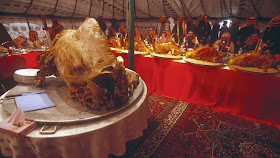Spidercam
Australian camels, roving in the only feral herds of their kind in the world and estimated to number 1,000,000, are descendants of camels imported into Australia, beginning in the mid-1800s, to help lay the foundations of the nation. Shipments came largely from the Indian subcontinent, but animals were also landed from Muscat, Yemen, Iraq and the Canary Islands.
Feral Camels in outback Australia
Australian camel meat can be cooked in almost any method in which you would cook lamb, (and it is a similar taste), the very best method is roasting.
Camel meat is a speciality in the Middle East
Roast Camel
In a deep roasting pan, or double pan if available, place approximately an inch (15cms) of water. Add the Camel meat roast. A sprinkle of curry powder is a good touch if the meat is not already marinated. Cover the meat with aluminium foil which will be removed in the last half hour of cooking.
By roasting in the water rather than oil, the meat will remain tender rather than drying out to which it is prone. The addition of a few peeled onions to the water will enhance the overall flavour.
Camel is often prepared as a stew. The small chopped pieces of meat tossed on plain flour before being added to a vegetable stock. With the addition of chosen vegetables and diced onion, ground black pepper and salt, and slow cooking, the stew produces a succulent melt in the mouth meal.
Camel can also be minced and used as burger meat. Once again we add chopped onion, choice of herbs, dash of curry powder, egg and breadcrumbs. Mix and cook exactly as you would with any hamburger mince. Diced bacon is an optional extra which may be added to main mix.
The camel neck is ideal for soups. It is very meaty and in a good vegetable stock will come away from the bone nicely. Diced root vegetables and onion with the addition of crushed tomatoes will make a hearty meal for a cold winters day. Enjoy!
Source:DK Mitchel at Helium.com



